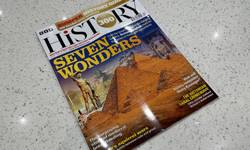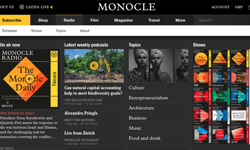I recently attended the Digital Magazine Unconference – a lively affair at The Stables in Camden Market where a number of print and digital publishing executives, designers, and content creators met to discuss the state of what the organisers called ‘the digital magazine industry’.
I came away from the morning disappointed at the lack of forward thinking and innovation from the media companies represented and the externalisation of the issues facing digital magazine publishers. The morning consisted mainly of attendees moaning about the supply chain (specifically Apple’s control of it), the failure of advertisers to recognise the value of the medium, and the difficulty of attracting new readers. At the end of the morning, a poll was taken to ascertain the appetite for a new body to be set up to champion the cause of the digital magazine industry. As I left, I was the only attendee who had, up to that point, placed their business card in the ‘No’ box.
The problem I have with the whole ‘digital magazine’ movement is that in its current guise, it has failed. We talk about a market that is in its infancy, but in reality, it is over three years since the launch of the iPad and in that time, there have been very few brands that have successfully migrated their print product into a digital proposition. The majority of the digital magazine industry is predicated on taking an existing print product, replicating the content (with perhaps some interactive elements which may or may not be relevant), replicating the frequency, and in many instances, replicating the advertising. The magazine is then loaded onto iTunes and left to fight for readers against thousands of other digital products without any marketing support to give it a chance of success. Upon failure, the natural next step therefore is to create an industry body to sell the concept to the wider world in the knowledge that if only advertisers and readers understood how good the products were, they would be buying into them in their droves.
evo’s first app
Dennis Publishing first launched evo as a digital magazine in 2010, the year the iPad launched. evo launched on the Adobe DPS platform (being the only game in town) with an interactive proposition and support from advertisers who were attracted to the potential opportunity. Being the first motoring magazine to market was a significant advantage, allowing evo to establish a circulation of around 6,000 subscribers and 4,000 monthly single issue sales. But even in 2010, the limitations of Adobe DPS were apparent – massive download size, significant impact on production workflows – particularly if we were looking to take a multi-platform approach, and development requirements that were entirely reliant on the Adobe pipeline for implementation. By mid-2012 we had also noticed that, despite significant increases in penetration of the iPad, evo had reached a plateau in terms of sales growth.
At the beginning of 2013, we decided to review the success of the current app and to consider how we felt our readers would be looking to access evo’s content in a digital medium over the coming years. To help the strategic process, we enlisted the help of Clearleft – a user-centred design consultancy who provided the framework in which to challenge our current thinking and to develop some ideas based on user research. Early research identified a significant difference in opinion between current subscribers of the app and the wider performance car enthusiast audience. Current users were very much wedded to what many had been receiving for over two years – a digital interpretation of the magazine with some interactive features delivered on the same day that the magazine went on sale in the UK. The fact that they had to endure a minimum wait of thirty minutes for the magazine to download (if it did so without crashing) and accept that each issue took up 750mb on their iPad, was testament to their dedication to the digital evo. But it was these and other restrictions which were putting off potential new users to the app. After very careful consideration, some fundamental decisions were made that would have a significant impact on the digital strategy for evo:
1. The new app should be able to be updated on a continuous basis, without the need to produce a new issue every time
2. The new app should offer time-bound access, not issue-bound access
3. The new app should be available on any device without the need for significant re-working for each platform
Continuous updating
In the digital world, the expectation is for regular and frequent interaction. With a four-weekly published app, there is just one opportunity per month to share content and interact with the audience. With most people accessing their tablet or smartphone on a daily basis, the risk of dropping off their radar is very high. The evo app can now accept continuous updates, and the team are currently uploading content into it about three times per week. Most of the content is taken from the magazine, but rather than the digital edition lagging behind the print magazine, evo digital leads it. This means that by the time the evo print edition hits the shelves, the content in it has generally already been published in the app. This is not so much a digital first publishing strategy as a publish when and where appropriate strategy. With so many embargoes placed on new car launches, such an approach allows evo digital to compete effectively with other, higher frequency titles. It also allows the digital edition to react to performance car news more rapidly. One natural development of that is the introduction of the weekly news briefing within the app which is not available anywhere else. In time, it is likely that the digital edition will further differentiate its content from that of the magazine as we learn what works better in that environment.
Continuous publishing has also had a significant and positive impact on the production schedule for the entire magazine. It was feared that the move to a continuous publishing model would create additional workload, but the production desk now run a weekly schedule which in turn has led to greater discipline in the commissioning and delivery of copy into the office – an unexpected bonus.
Timed access to content
The traditional management of magazine subscriptions within the digital age reflects the conventions and limitations of print. Readers subscribe to a physical number of issues and purchase back issues if desired. This approach is at odds with those companies such as LoveFilm and Spotify which grant access to entire libraries of content for a fixed period of time. With the launch of the new app, evo took a decision to open up its archive, and grant access to the archive for all users in return for a monthly subscription fee. The team are still loading archive content into the app, but anyone subscribing to one month of access now has twelve months of content to browse through. To enable interaction with content, uploaded content is tagged in a number of ways to allow searching of features. It is possible, for example, to access just Ferrari content or just first drives, creating a powerful resource beyond just the boundaries of a specific physical issue.
Create Once, Publish Everywhere
In taking a decision to create a new app, it was important that it could be deployed on all devices rapidly. One of the problems with Adobe DPS was the substantial re-design between individual platforms, and the requirement for high-value design resource to be used in that process. When evo had its interactive DPS edition, it had a dedicated digital designer to support the creation of each issue. It was also undertaken as an additional task after the main issue had closed, generating a delay before the digital edition could be published. The new app, built in HTML5, is responsive, so it can be published across iPad, iPhone, and all Android devices with no additional intervention. To do so requires a substantial amount of upfront development to create templates, but once in place, the creation of content is a production process rather than a design one. Templating of content does lead to an inevitable reduction in the interactivity of the content, although the templates, built on Kaldor’s Pugpig platform can be enhanced using additional software plugins such as Contentment’s Padify. The move to multi-platform has had a significant impact on the penetration of the app.
Results to date
It is fair to say that reaction to the new evo app has been mixed. Those readers who have been loyal to the previous interactive magazine format have generally been vociferous in their rejection of the concept. Having taken away their back issues, removed some of the interactivity, and replaced a much loved magazine experience with a constantly updating one, the reaction from the traditional market was, to some extent, expected. The importance of the ‘magazine experience’ – the content curation and the feeling of completion once an issue has been read were things we were aware of but probably did not give sufficient priority to. As a result, the ratings for the app in iTunes have been split – a large number of 5 stars but a significant number of 1 star reviews. On Android, where evo has not previously existed as an app, the general view has been much more positive, with an average score of 3.8 out of 5.
But the project was always seen as a long-term move. There are significantly more people looking for performance car content in a digital environment that just looking to replicate evo as an interactive magazine. That is the bigger prize which Dennis Publishing are looking to win.
Whilst it is too early to say whether the numbers will convert into revenue, initial downloads have been strong. evo, across all platforms, has been downloaded over 90,000 times in the ten weeks since launch and as at 15 December, had 25,000 accessing it in the previous week. Advertising interest has been strong and we have just been included in Apples ‘Best of 2013’ list on both the iPad and the iPhone.
Whilst there remains a lot to do, with a development plan in place throughout 2014, the risk that we took to move from a ‘digital magazine’ to what we now have is one we are comfortable with. Time will tell, but it is important that publishers look to challenge the way they have been doing things, and not assume that what works in a paper product will transfer seamlessly to an app.












